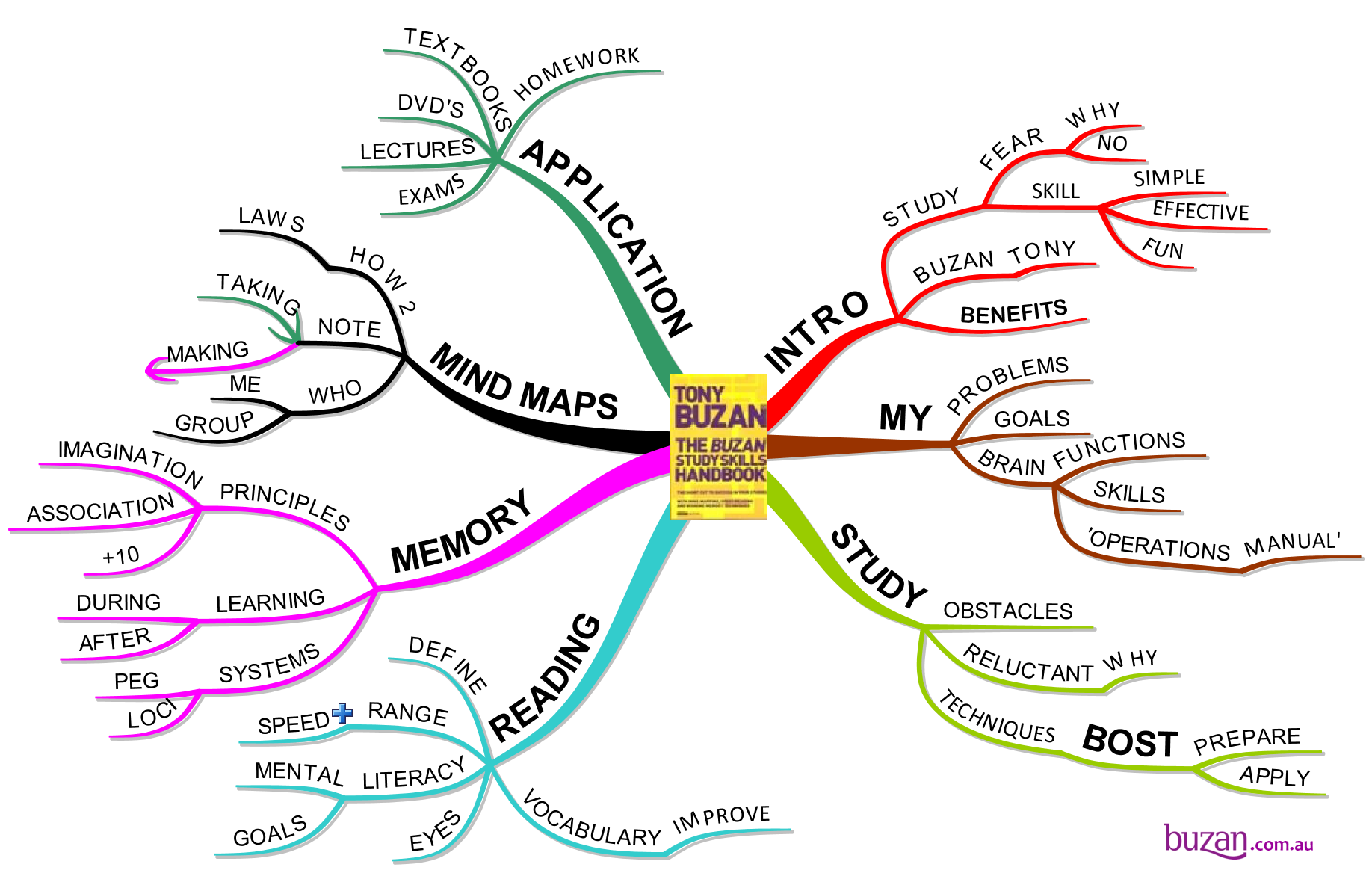Theory behind Mind Maps
As you read about the nature and workings of your memory and about your brain’s other major functions, you will realize the extraordinary extent of its capacity and potential.
The Mind Map is a tool used to entice, delight, stimulate and challenge you. You will discover some astonishing facts about your brain and its function, and you will take the first major steps on the path to freedom of the mind.
What is a Mind Map?
A Mind Map is a highly effective way of getting information in and out of your brain – it is a creative and logical means of note-taking and note-making that literally “maps out” your ideas.
All Mind Maps have some things in common. They have a natural organizational structure that radiates from the center and use lines, symbols, words, color and images according to simple, brain-friendly concepts. A Mind Map converts a long list of monotonous information into a colorful, memorable and highly organized diagram that works in line with your brain’s natural way of doing things.
One simple way to understand a Mind Map is comparing it to a map of a city. The city center represents the main idea; the main roads leading from the center represent the key thoughts in your thinking process; the secondary roads or branches represent your secondary thoughts, and so on. Special images or shapes can represent landmarks of interest or particularly relevant ideas.
The Mind Map is the external mirror of your own radiant or natural thinking facilitated by a powerful graphic process, which provides the universal key to unlock the dynamic potential of the brain.
The five essential characteristics of a Mind Map:
- The main idea, subject or focus is crystallized in a central image.
- The main themes radiate from the central image as ‘branches’.
- The branches comprise a key image or key word drawn or printed on its associated line.
- Topics of lesser importance are represented as ‘twigs’ of the relevant branch.
- The branches form a connected nodal structure.

The brain’s natural architecture and foundation of Mind Maps
Radiant Thinking – a clearer, more natural and more efficient way of using our brains
What happens in your brain when you taste a ripe pear, smell flowers, listen to music, watch a stream, touch a loved one, or simply reminisce? The answer is both simple and amazingly complex. Each bit of information entering your brain, every sensation, memory or thought, which incorporates every word, number, code, food, fragrance, line, color, image, beat, note and texture can be represented as a central sphere from which radiate tens, hundreds, thousands, even millions of hooks. Each hook represents an association, and each association has its own infinite array of links and connections. From this gigantic information processing ability and learning capacity derives the concept of Radiant Thinking of which the Mind Map is a manifestation. Your brain’s Radiant Thinking pattern may thus be seen as a gigantic Branching Association Machine – a super bio computer with lines of thoughtradiating from a virtually infinite number of data nodes.
State-of-the-Art Research into the Left and Right Hemispheres
Almost the moment Mind Maps came into use another major piece of scientific research confirmed their validity as a brain-compatible thinking method. In California, Dr. Roger Sperry, who won a Nobel Prize for his research, confirmed that the evolutionarily latest part of the brain, the ‘thinking cap’ of the Cerebral Cortex, was divided into two major hemispheres, and those hemispheres performed a comprehensive range of intellectual tasks, called cortical skills. The tasks included: Logic, Rhythm, Lines, Color, Lists, Daydreaming, Numbers, Imagination, Word, Gestalt (seeing the whole picture). Sperry’s own research confirmed that the more these activities were integrated, the more the brain’s performance became co-operative, with each intellectual skill enhancing the performance of other intellectual areas. When you are Mind Mapping®, you are not only practicing and exercising the fundamental memory powers and information processing, you are also using your entire range of cortical skills.
The Mind Map is made even more powerful by the use of all the left and right brain-thinking tools, which enhance the clarity, structure and organization of your thinking. And because the Mind Map constructively uses the tools of Imagination, Associationand Location, as well as the tools of the left and right brain, you can consider the Mind Map the ultimate thinking tool that incorporates all the significant and potent ways of thinking into its own structure.
The Power of Images
If the Radiant Thinking ability of the brain can be applied to the ‘left cortical skill’ of words, can the same power be applied to the ‘right cortical skill’ of imagination and images? In 1970 Scientific American magazine published Ralph Haber’s research showing that individuals have a recognition accuracy of images between 85 and 95 percent. There is a well-known quote, “A picture is worth a thousand words”. We associate and remember images because they make use of a massive range of your cortical skills, especially imagination. Images can be more evocative than words, more precise and potent in triggering a wide range of associations, thereby enhancing creative thinking and memory. These findings support the argument that the Mind Map is a uniquely appropriate tool. It not only uses images, it is an image.
Tony Buzan and Mind Mapping
Although people have been creating maps using an image-centered radial graphic organization technique for centuries, British psychology author Tony Buzan has made a claim to the origin of the Mind Map. He argues that ‘traditional’ outlines require that the reader scans the information from left to right and top to bottom, whilst the brain’s natural preference is to scan the entire page in a non-linear fashion. Buzan also uses widespread assumptions about the cerebral hemispheres in order to promote the exclusive use of mind mapping over other forms of note making.
